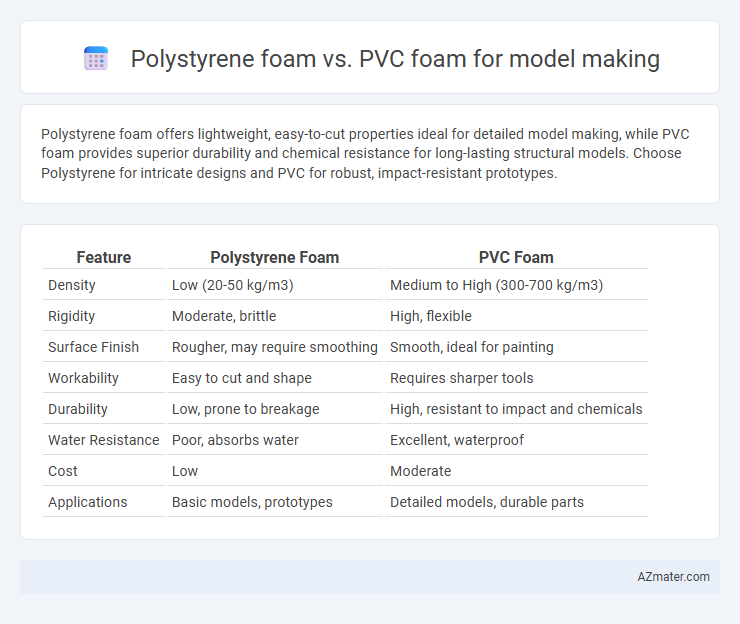Polystyrene foam offers lightweight, easy-to-cut properties ideal for detailed model making, while PVC foam provides superior durability and chemical resistance for long-lasting structural models. Choose Polystyrene for intricate designs and PVC for robust, impact-resistant prototypes.
Table of Comparison
| Feature | Polystyrene Foam | PVC Foam |
|---|---|---|
| Density | Low (20-50 kg/m3) | Medium to High (300-700 kg/m3) |
| Rigidity | Moderate, brittle | High, flexible |
| Surface Finish | Rougher, may require smoothing | Smooth, ideal for painting |
| Workability | Easy to cut and shape | Requires sharper tools |
| Durability | Low, prone to breakage | High, resistant to impact and chemicals |
| Water Resistance | Poor, absorbs water | Excellent, waterproof |
| Cost | Low | Moderate |
| Applications | Basic models, prototypes | Detailed models, durable parts |
Introduction to Polystyrene Foam and PVC Foam
Polystyrene foam, known for its lightweight and rigid structure, is widely used in model making due to its ease of cutting and shaping, offering excellent thermal insulation properties. PVC foam, denser and more durable than polystyrene, provides superior impact resistance and smooth surfaces ideal for detailed model work and painting. Both materials serve distinct purposes in model making, with polystyrene favored for simple prototypes and PVC preferred for finished, durable models.
Material Properties Overview
Polystyrene foam offers lightweight structure, high rigidity, and excellent insulation, making it ideal for detailed model making where precision and ease of cutting are essential. PVC foam provides superior durability, chemical resistance, and impact strength, suitable for models requiring robust handling and long-term stability. Both materials vary in density and surface finish, affecting paint adhesion and finishing quality in model construction.
Weight and Density Comparison
Polystyrene foam typically has a lower density ranging from 10 to 30 kg/m3, making it significantly lighter than PVC foam, which usually ranges between 60 to 250 kg/m3. The lighter weight of polystyrene foam enhances ease of handling and reduces overall model weight, ideal for lightweight architectural or prototype models. PVC foam offers higher density and strength, benefiting applications requiring more structural integrity but at the cost of added weight.
Ease of Cutting and Shaping
Polystyrene foam offers exceptional ease of cutting and shaping due to its lightweight and soft texture, making it ideal for intricate model details and quick adjustments. PVC foam, while denser and more durable, requires sharper tools and more effort to cut but provides a smoother surface finish and greater structural stability. Model makers often choose polystyrene foam for rapid prototyping and detailed work, whereas PVC foam suits projects demanding lasting strength and precision.
Surface Finish and Paintability
Polystyrene foam offers a smooth surface finish ideal for detailed model making but tends to absorb paint unevenly, requiring a primer for optimal results. PVC foam features a denser, uniform surface that enhances paint adhesion and provides a durable, professional appearance with less preparation. Both materials benefit from sanding and sealing techniques, yet PVC foam generally delivers superior paintability and a more consistent finish for high-quality models.
Strength and Durability
Polystyrene foam offers lightweight properties but has lower strength and durability compared to PVC foam, making it more susceptible to dents and damage during model handling. PVC foam is denser and provides superior resistance to impact, moisture, and chemical exposure, ensuring longer-lasting models in demanding environments. The enhanced toughness and structural integrity of PVC foam make it the preferred choice for model makers requiring robust and durable components.
Cost and Availability
Polystyrene foam offers a cost-effective and widely available material ideal for model making, providing ease of shaping and lightweight properties at a lower price point than PVC foam. PVC foam, while more expensive, delivers enhanced durability and chemical resistance, making it suitable for models requiring long-term use and finer detail work. Both materials are readily accessible through hobby stores and online suppliers, but polystyrene's lower cost and ubiquitous presence make it the preferred choice for budget-conscious model makers.
Environmental Impact and Safety
Polystyrene foam, commonly used for model making, is lightweight but environmentally problematic due to its non-biodegradable nature and difficulty in recycling. PVC foam offers better durability and chemical resistance but releases toxic chlorine-based compounds during production and disposal, posing greater environmental and health risks. Both materials require careful handling and disposal to minimize their ecological footprint and potential hazards to users.
Applications in Model Making
Polystyrene foam is widely used in model making due to its lightweight nature, ease of cutting, and smooth finish, making it ideal for architectural models, prototypes, and terrain modeling. PVC foam offers superior durability, chemical resistance, and a rigid structure, which is preferable for detailed scale models, signage, and structural components requiring long-term stability. Both materials cater to distinct needs in model making, with polystyrene favored for quick, economical projects and PVC foam chosen for precision and durability.
Choosing the Right Foam for Your Project
Polystyrene foam excels in lightweight modeling with ease of cutting and shaping, making it ideal for detailed prototypes and architectural models. PVC foam offers superior durability, chemical resistance, and a smooth surface, preferred for robust models requiring sanding and painting. Selecting foam depends on project needs: use polystyrene for cost-effective, intricate designs and PVC for lasting, high-quality finishes.

Infographic: Polystyrene foam vs PVC foam for Model making
 azmater.com
azmater.com